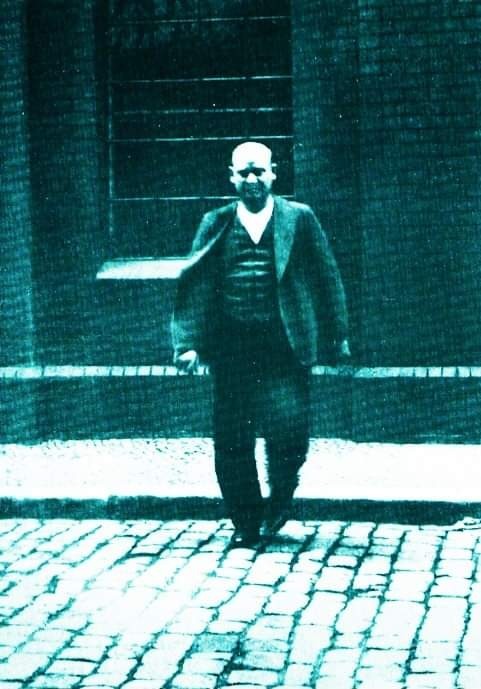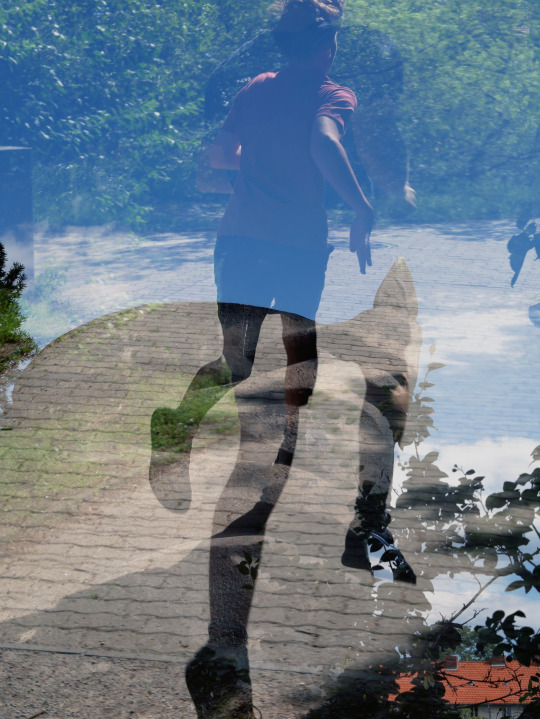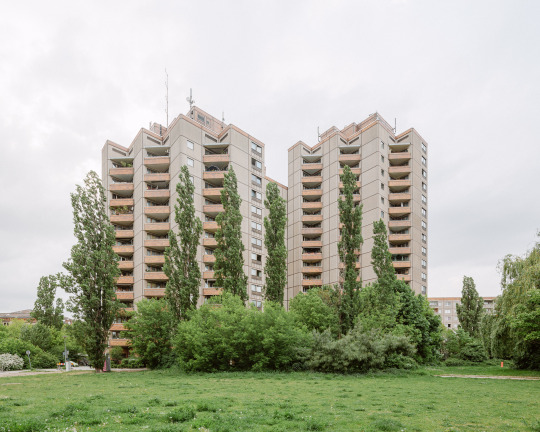#ernst thälmann
Text

The Class E11 was the first electric locomotive class built in the GDR, with production starting in 1961. Pictured here is 211 001-3 in the Deutsche Bahn Museum in Nuremberg.
The factory where it was built carried the name of Hans Beimler, who among other things served as a political officer in the famous Thälmann-Batallion for the International Brigades in the spanish civil war, where he was killed in action. In his earlier life he was working in a locomotive factory in Nuremberg, where he was part of the works council. His Grandson (also called Hans Beimler) lives in the USA and most notably wrote for Star Trek TNG.
@valtionrautatiet-official
@punalippulaiva
@femboytrain
#E11#public transit#deutsche bahn#deutsche reichsbahn#Hans Beimler#nürnberg#nuremberg#Thälmann#wählt thälmann#ernst thälmann#locomotive#trains#analog photography#ФЭД2#FED 2#feliks appreciation post#washi D#500 ISO#star trek#TNG
20 notes
·
View notes
Photo

#DDR#plattenbau#Prefabricated Buildings#architecture#ostmodern#ostberlin#ernst-thälmann-park#ernst thälmann#wartburg#панельки
48 notes
·
View notes
Text


Wählt Thälmann, Weimar - Marburg
Two surviving political graffiti from 1932 instructing people to vote for Ernst Thälmann, head of the KPD (Communist Party of Germany).
The Communists lost the election and Hitler took over a few months later. Ernst Thälmann was arrested by the Nazis on 3rd of March, 1933. He was murdered in the Buchenwald concentration camp in August 1944.
#ernst thälmann#its so crazy to me that the world of 1932 and of 1933 and of [...] is still... OUR WORLD#somehow these outlasted everything that happened
9 notes
·
View notes
Text

Ernst Thälmann on the prison yard at Berlins police headquarter after having been arrested by German fascists on March 3, 1933.
This photography was taken in secret through a gate. It is most likely the last known photography of this communist leader and Hitlers most feared enemy.
39 notes
·
View notes
Text
youtube
0 notes
Text

'Monumente sollen stehen oder nichts - Hohnstein’
Digital Collage, 375 x 375 mm, 2024
Fine Art Pigment Print under Acrylic Glass,
Black Aluminium Art Box
Based on the series 'Monumente sollen stehen oder nichts', which deals with Ernst Thälmann, his monuments in the GDR and the treatment of other socialist monuments after the political change in 1989, this picture cycle deals with places that bore the name Ernst Thälmann and have disappeared.
#sb2130#Bernhard Schipper#NSK#Neue Sorbische Kunst#German History#NSK Folk Art#Ernst Thälmann#DDR#KPD#Working Class Hero#Arbeiterführer#Hohnstein#Jugendburg#Puppentheater#Jugendherberge#Konzentrationslager#Internierungslager#Hohnstein Kasper#Leipzig Art#Leipzig Artist#Sorbian Artist#Autochthon#Sorbian
0 notes
Text
Sacharowa: Zerstörung des Denkmals wäre eine zweite Ermordung Thälmanns
Vielen in der Berliner Politik ist es ein Dorn im Auge, das Thälmann-Denkmal in Prenzlauer Berg. Wie es nach außen wirkt, wenn ein Denkmal für einen bedeutenden Antifaschisten angegriffen wird, lässt sich am Kommentar von Maria Sacharowa erkennen.
Maria Sacharowa, die Sprecherin des russischen Außenministeriums, hat sich im Telegram-Kanal des Ministeriums zu der in Berlin immer wieder…

View On WordPress
0 notes
Text


friends hanging out in the void
#countryhumans#ch belarus#ch east germany#gonna be honest with you guys I couldn’t manually draw their flags if I tried#anyways I think they’re best friends :)#and yes that is an ernst thälmann pioneer uniform
16 notes
·
View notes
Text

Der Park / 21.08.2023
0 notes
Photo










Bachelor Thesis: Day 08
Berlin
Prenzlauer Berg
Ernst-Thälmann-Park
Canon TS-E 17mm f/4L
Canon EF 24mm f/1.4L II USM
Canon EOS 5D Mark III
#Canon EOS 5D Mark III#Canon TS-E 17mm f/4L#Canon EF 24mm f/1.4L II USM#germany#Deutschland#Berlin#Pankow#Prenzlauer Berg#Ernst-Thälmann-Park#architecture#Architektur#socialistmodernism#postwarmodernism#geometry#tristesse#dystopia
0 notes
Note
I'm not sure if you can answer this, but what is it that (in general, not just based on the current state of affairs) seems to cause people in more left leaning circles to constantly underestimate the danger that the far right poses?
Like, this seems to be a consistent pattern, given what I've read up on men like Ernst Thalmann and the like, who keep on treating the right wing as being less of a threat than the center or not as left as the left. For that matter, why do they keep insisting that the center is worse than the right, even when it's pretty evidently not the case?
My quasi-educated guess would be that it's because of something called "the psychology of small differences." See where people who live next door to each other, in the same neighborhood, or in the same country (or in countries right next to each other) hate each other far more than unknown people far away, because these people are almost like them but then aren't, and that's a threat to their identity and their sense of themselves. Hence we have leftists insisting that liberals or even centrists are somehow Much Worse!!! than literal far-right fascists, even if it makes no sense, because it doesn't have to do with logic, reality, or an objective appraisal of the situation, but a threat to their personal sense of themselves and/or selfish view of themselves as clearly the best and most moral ever. As such, something something people who almost agree with them, but not quite, are actually worse than their open enemies.
Also, I'm glad you mentioned Ernst Thalmann. People should read up on him. He was the leader of the German Communist Party from 1925-33, and played an explicit part in aligning them with Stalinist Russia and vigorously demonizing the liberal/left-wing establishment German political party, the Social Democrats, as "social fascists" who were obviously worse than the boorish failed artist Austrian populist guy running for the National Socialist Workers' Party:
....except the National Socialist Workers' Party was, you know, the Nazis, the guy running for them was Adolf Hitler, Thalmann spent so much time attacking the Social Democrats as "just as bad" that it was impossible for the German leftist and liberal/socialist/communist factions to work together, and Hitler was elected in 1933. Good thing nothing bad happened after that, right?
Anyway. Don't be Ernst Thalmann. The end.
119 notes
·
View notes
Text
Yes Virginia, The Nazis Were Fascists - Part Three
(this is part three of a continuation of a discussion we've been having with an Anon who challenged us to define fascism. In our previous response, we provided Anon with a photo of a poster from the United States Holocaust Memorial Museum, a bullet list from Yale professor Jason Stanley, quotes from William Reich, Ludwig von Mises, Harold Nicolson, Franklin D. Roosevelt, Henry A. Wallace, Marcus Garvey, a link to a video breakdown of the subject by Philosophy Tube, and recommendations to read books by historians Mark Bray, Robert O. Paxton, Umberto Eco, and Hannah Arendt - all of whom have published key works on the topic. Anon did not do his homework and instead sent us an immediate reply, informed solely by the two images we included in our response, ignoring everything else we cited. His reply includes some, uhh, pretty incredulous claims. In this post, we crack our knuckles, get someone to hold our beer, and tee off).
ANON: Once again, the nazis wouldn't be considered fascists. They weren't capitalists.
The nazis were absolutely capitalists, Anon, despite what they may have said early on as they rose to power. Historian Robert O. Paxton again:
"Whenever fascist parties acquired power, however, they did nothing to carry out these anticapitalist threats." (Ibid., pg. 10).
"In practice, although fascist regimes did indeed make some breath-taking changes, they left the distribution of property and the economic and social hierarchy largely intact (differing fundamentally from what the word revolution had usually meant since 1789). The reach of the fascist “revolution” was restricted by two factors. For one thing, even at their most radical, early fascist programs and rhetoric had never attacked wealth and capitalism as directly as a hasty reading might suggest. As for social hierarchy, fascism’s leadership principle effectively reinforced it, though fascists posed some threat to inherited position by advocating the replacement of the tired bourgeois elite by fascist 'new men.'” (Ibid., pg. 141) The crony capitalism enacted by the nazis let brute force to the profit motives of their capitalist allies that helped them seize power, by providing capitalists with murderous anti-union violence, valuable assets seized from Jews and other "enemies of the state," lucrative government contracts doled out based on a company's devotion to Hitler, and slave labour.
ANON: Corporate power wasn't necessarily protected (whatever that means). Labour power wasn't suppressed.
AI: You're plainly wrong on both counts. The nazis developed an economic system called "crony capitalism" where wealthy business owners were given tremendous advantages if they allied with and supported the nazis, including repression of trade unions, rewarding resources looted from competitors, and the use of slave labour. Major German corporations like Krupp and I.G. Farben did exactly that. "Businessmen contributed hugely to the new Nazi authorities and set about accommodating themselves to a regime that would reward many of them richly with armaments contracts, and all of them by breaking the back of organized labor in Germany." (Robert O. Paxton, The Anatomy of Fascism, pg. 100).
Another big perk for corporations supporting the nazis was their promise to violently repress labour unions. In 1933, the nazis outlawed independent labour unions and forced workers to join the nazis' own rat union. They also froze workers' wages. Some of the first people sent to nazi concentration camps were union leaders like Ernst Thälmann - thousands of union activists were tortured and executed between 1933 and 1945.
94 notes
·
View notes
Text




"Viele Grüße auch an Vati, und daß er bald wieder gesund ist."
Ansichtskarte
Fichtenwalde, Kreis Potsdam.
Konsum-Verkaufstelle
Ernst-Thälmann-Straße.
Potsdam: PGH Fotostudio Potsdam (1/16/18 F 33/77)
1977
#Fichtenwalde#Bezirk Potsdam#1970er#1977#Kaufhalle#Philokartie#DDRPhilokartie#Architekturphilokartie#EinkaufskulturDerDDR#AlltagskulturDerDDR#Ansichtskartenfotografie#AnsichtskartenfotografieDerDDDR#deltiology#VintagePostcard#akFichtenwalde#BezirkPotsdam
20 notes
·
View notes
Text
The prospects of a united front preventing Donald Trump returning to power in the US looked a little bleaker this week.
Let’s be frank they weren’t great to begin with. To an outsider Joe Biden just seems to be too old to be a viable candidate. He doesn’t pass the first impressions test. Look at him and you do not see someone capable of serving another four years.
True, he won Michigan's Democratic presidential primary a few days ago– but he was hit by a significant protest vote from left-wing and Arab-American voters angry about his qualified support for Israel's war in Gaza.
And at this point that second cause for worry, and, frankly, panic kicks in.
The left urged registered Democrats to vote for the "none of the above" category to express their opposition to Biden's Israel policy – and about 100,000 did. Their votes represent a wider chunk of the electorate who could well stay at home or vote for minor Green or left-wing candidates and deny the Democrats key states.
In a deeply divided country with a warped electoral system that favours the Republicans, it does not take many voters abandoning the Democrats for Trump to retake power.
I wrote at the weekend about how the Trump example shows how hard it is to unite against a dictatorial threat. People, or to be fair, many people, cannot put aside their commitments and ally with men and women they profoundly disagree with for the greater good of defending democracy.
On the one hand, they cry that Trump is a fascist and white supremacist. On the other hand, they refuse to use all available means to stop him. Mainstream liberals do not moderate their demands to win over wavering conservatives. The far left sees the Biden administration as its true enemy.
The history of the struggles against Nazism are highly relevant to the dilemmas and the dangers we face today.
As Hitler began his rise to power at the end of the 1920s, the European far left was in the same place as a section of the modern US left.
The threat of fascism was as nothing when set against its hatred of moderates.
In 1928 the communist movement adopted one of the cruellest and stupidest policies in its history, which considering the history of Soviet communism was nothing more than a history of cruelty and stupidity was quite an achievement.
Partly because it helped Stalin in his internal power struggles in Russia, Moscow ordered all Europe’s communists to follow an ultra-leftist policy. They were told to denounce moderate leftists as “social fascists”, and fight them to the death.
Communism’s triumph was inevitable, the party line went. No compromise was possible with anyone who stood in history’s path. Reformists were opportunists and traitors. They were social fascists who were as bad as the Nazi gangs which were already gathering on Berlin streets.
Or perhaps they were worse….
For an argument that is still heard today held that, say what you like against them, at least fascists were honest in their way.
By contrast centre-leftists were traitors who had been “bribed by the bourgeoisie” to deceive the masses, as no less an authority than Lenin had said.
They were hypocrites who pretended to want change while watering it down. Nothing could be achieved until they were swept away.
When Stalin’s enemy, Leon Trotsky, who was hardly a moderate, warned that instructing left-wingers to fight other left-wingers was a sure way of allowing fascism to “ride over your skulls and spines like a terrific tank”, Ernst Thälmann, the leader of the German communist party, denounced him for his ‘criminal counter-revolutionary propaganda’.
The result was a disaster. The communists and socialists fought each other instead of the Nazis, making Hitler’s rise easier. Thälmann went along with Stalin’s categorisation of social democrats as “social fascists” until actual fascists came to power in Germany. They taught him the difference by holding him in solitary confinement for 11 years at the Buchenwald concentration camp, and putting him before a firing squad in 1944 and shooting him dead.
Today there are plenty of Thälmanns who believe with absolute certainty that the discredited centrist mainstream is the enemy.
Here is a columnist on the Washington Post greeting the Michigan result

As I emphasised in my previous piece, his stance is absolutely fine in normal circumstances. US leftists are perfectly entitled to refuse to support the Democrats if Biden’s behaviour outrages them.
But surely only enormous levels of delusion prevent them acknowledging that Trump is a threat to democracy. If he wins, the American republic may be so gerrymandered and its civil service so politicised that it will be a Herculean task to remove Trump and his successors. There are plenty on the US far right who cite the rigged democracy of Viktor Orban’s Hungary as their model and dream, after all.
The alternative is to build alliances and once again history is a guide,
Having seen that their previous policy of treating moderate leftists as Nazis had resulted in Hitler coming to power 1933, the geniuses running the Soviet Communist party decided on a U-turn. Henceforth communists were instructed to support “popular front” movements where everyone opposed to the fascist threat would be welcome.
Some of the most interesting US writers have reached back to the 1930s to find ways of dealing with Trump. In How Democracies Die the US academics Steven Levitsky and Daniel Ziblatt found an example in the little-known story of how fascism was stopped in Belgium in the 1930s.
Belgium might have gone the same way as fascist Italy or Nazi Germany. In 1936 far-right outfits —the Rex Party and the Flemish nationalist party, or Vlaams Nationaal Verbond (VNV)—surged in the polls, capturing almost 20 percent of the popular vote.
They challenged the historical dominance of three establishment parties: the centre-right Catholic Party, the Socialists, and the liberals.
The leader of the Rex Party, Léon Degrelle, was a classic far-right figure. A journalist (like Mussolini, and so many other believers in simple solutions) he would go on to become a Nazi collaborator in the Second World War.
Levitsky and Ziblatt wrote that, “the Catholic Party, in particular, faced a difficult dilemma: collaborate with their longtime rivals, the Socialists and Liberals, or forge a right-wing alliance that included the Rexists, a party with whom they shared some ideological affinity.”
Unlike the mainstream conservative politicians of Italy and Germany, who brought Mussolini and Hitler to power, or the mainstream Republican leadership who collaborated with Trump, the Belgian Catholic leadership declared that any deals with the far right could not be contemplated.
"Catholic Party leaders heightened discipline by screening candidates for pro-Rexist sympathies and expelling those who expressed extremist views. In addition, the party leadership took a strong stance against cooperation with the far right. Externally, the Catholic Party fought Rex on its own turf. The Catholic Party adopted new propaganda and campaign tactics that targeted younger Catholics, who had formerly been part of the Rexist base. They created the Catholic Youth Front and began to run former allies against Degrelle."
Right-wing Catholics knew that they must ally with socialists and liberals they normally deplore in a popular front. And it worked. The far right was beaten.
I think popular front politics are essential. But they are not easy or even particularly principled. Go back to the 1940s and you find George Orwell was utterly repelled by communists and conservatives allying to stop Hitler
He looked back with mockery on
“The years 1935-9 were the period of anti-Fascism and the Popular Front, the heyday of the Left Book Club, when red Duchesses and ‘broadminded’ deans toured the battlefields of the Spanish war and Winston Churchill was the blue-eyed boy of the Daily Worker.”
To Orwell, the idea of covering up the crimes of communists for the sake of the greater anti-fascist good was horrific. But that was what the left of the 1930s did. And that was what the British and American governments did during the Second World War. Defeating Hitler came first. They were prepared to forget about the millions Stalin killed until the war was over.
It's a hard choice. But in the circumstances US progressives face, it is an obvious one. There is no argument against making every necessary compromise to prevent a second Trump term. You will have no right to protest, if you do not.
17 notes
·
View notes
Text

'Monumente sollen stehen oder nichts - Oberhof’
Digital Collage, 375 x 375 mm, 2024
Fine Art Pigment Print under Acrylic Glass,
Black Aluminium Art Box
Based on the series 'Monumente sollen stehen oder nichts', which deals with Ernst Thälmann, his monuments in the GDR and the treatment of other socialist monuments after the political change in 1989, this picture cycle deals with places that bore the name Ernst Thälmann and have disappeared.
The second part of the new 'Monuments' series addresses the historical stratifications that made the originally insignificant village of Oberhof in Thuringia into a social and sporting center of German history from the imperial era through the Third Reich to the showpiece location of the GDR . I consciously chose a motif from the Ernst Thälmann House, which also contains the monument to Duke Ernst II. A deer with her fawn looks at the building from this perspective. The monument was not removed during GDR times - only the reference to Duke Ernst II was replaced by the city coat of arms of Oberhof. The silhouette of the deer appears shadowy in the wood grain of the background, which appears to be looking at the viewer and looking down at the deer in the picture.
The green signet with the Ernst Thälmann lettering, which was used in the first picture in the series, was originally designed for the Ernst Thälmann House restaurant in Oberhof. It is one of the original references for this dysfunctional place of remembrance, in which historical events from several eras overlap without being processed. The whole setup in this folksy kitschiness in the absence of any modernity illustrates the petty bourgeois nature of GDR socialism.
#sb2130#Bernhard Schipper#NSK#Neue Sorbische Kunst#Ernst Thälmann#Oberhof#Ernst Thälmann Haus#Leipzig Artist#Sorbian Artist#Sorbian Art#Monument#DDR#KPD#Working Class Hero#Thuringia#Rennsteig#Winter Sports#Olympics#HerzogCarlEduard#German History#NSK Folk Art#Neue Slowenische Kunst
0 notes
